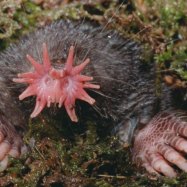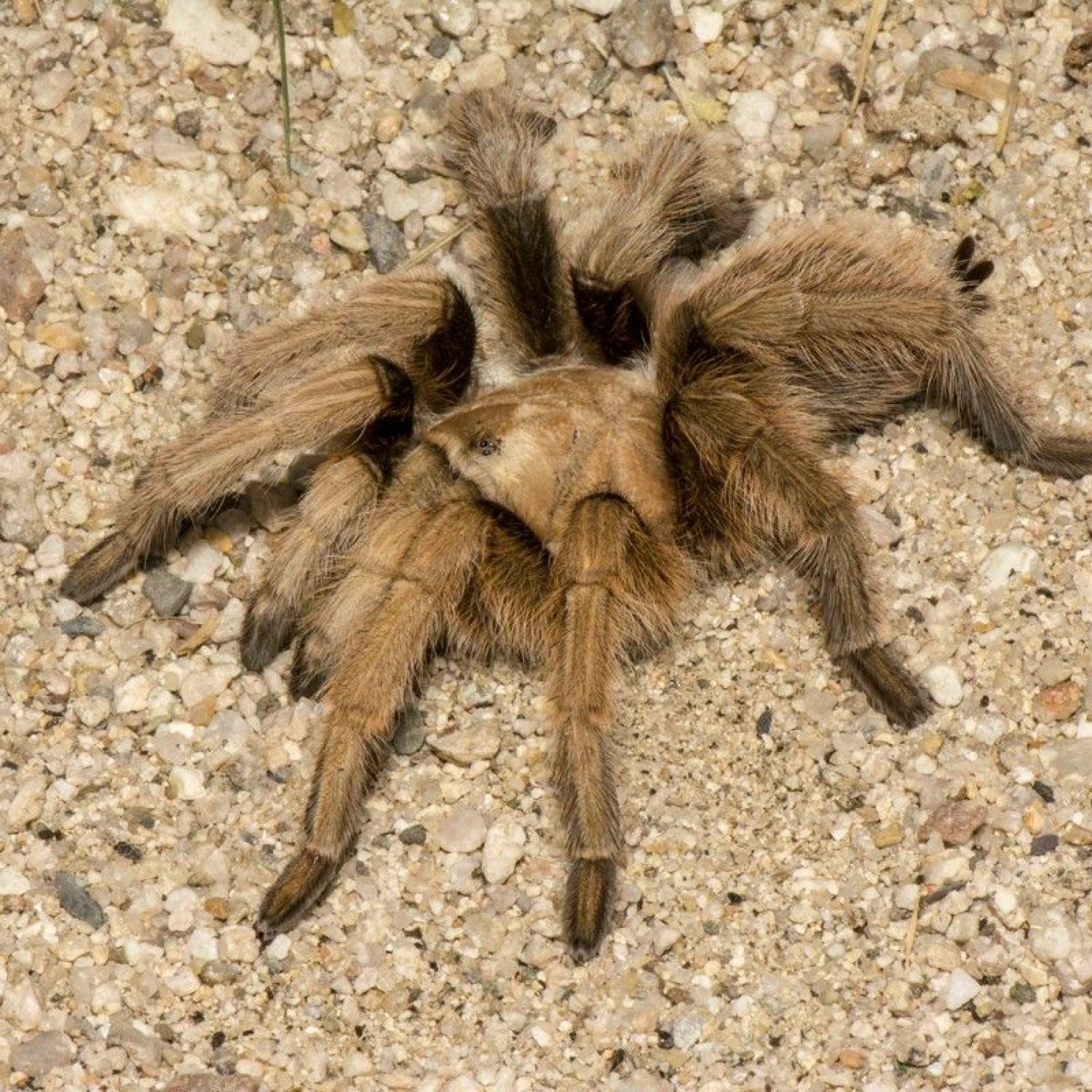
Arizona Blonde Tarantula
3-4 inches (7.6-10.2 cm)
The Arizona Blonde Tarantula, found in Arizona, is a large and robust spider with a length of 3-4 inches. It belongs to the Theraphosidae family and is known for its distinct golden hairs. Despite its intimidating appearance, it is a docile and low maintenance pet for arachnid enthusiasts.
Animal Details Summary:
Common Name: Arizona Blonde Tarantula
Kingdom: Animalia
Habitat: Desert regions
The Enigmatic Beauty of the Arizona Blonde Tarantula
When people think of spiders, they often conjure up images of creepy, crawly creatures that invoke fear and disgust. However, in the diverse world of spiders, there is one species that stands out for its unique and captivating characteristics – the Arizona Blonde Tarantula. With its striking appearance and intriguing behaviors, this arachnid is sure to leave you in awe and admiration.The Taxonomic Classification of the Arizona Blonde Tarantula
Before we delve into the wonder of the Arizona Blonde Tarantula, let's first understand its place in the animal kingdom Arizona Blonde Tarantula. Scientifically known as Aphonopelma chalcodes, this magnificent creature belongs to the family Theraphosidae, which is the largest family of spiders. Its scientific name is derived from the Greek words "aphonos" meaning "voiceless" and "pelma" meaning "foot", referring to the lack of stridulating organs on its feet.The Arizona Blonde Tarantula falls under the phylum Arthropoda, which includes all invertebrate animals with a segmented body and jointed limbs. It also belongs to the class Arachnida, which comprises spiders, scorpions, ticks, and mites. Within the class Arachnida, these tarantulas fall into the order Araneae, making them true spiders.
The Habitat and Distribution of the Arizona Blonde Tarantula
The Arizona Blonde Tarantula is endemic to the Southwestern United States, with its primary range being in Arizona, hence its common name. These spiders have also been spotted in other southwestern states such as New Mexico, California, and Utah. They are known to inhabit high desert regions, including grasslands, scrublands, and rocky areas.One of the most fascinating things about the Arizona Blonde Tarantula is its adaptability to its harsh desert habitat Archaeoindris. These resilient creatures have developed unique behaviors and physical features that enable them to survive in their arid environment. For instance, they dig shallow burrows to seek refuge from the scorching heat and to regulate their body temperature. These burrows also serve as a means of trapping moisture, which is essential for their survival.
The Physical Appearance of the Arizona Blonde Tarantula
The Arizona Blonde Tarantula is undoubtedly a sight to behold, with its distinct features and eye-catching coloration. These spiders are typically medium-sized, with a body length ranging from 3-4 inches (7.6-10.2 cm). Their large and robust bodies are covered in long, golden hairs, which give them their trademark "blonde" appearance. However, depending on their age and gender, the intensity of their coloration can vary from a light tan to a vibrant golden brown.Aside from their striking coloration, Arizona Blonde Tarantulas also have prominent fangs, eight long and spindly legs, and two small pedipalps, which are used for sensing, climbing, and manipulating prey. Interestingly, male Arizona Blonde Tarantulas have longer and thinner legs compared to females, which is believed to help them navigate the female's burrow during mating.
The Feeding and Behavior of the Arizona Blonde Tarantula
Like most spiders, the Arizona Blonde Tarantula is a carnivorous creature, meaning it feeds on other animals. These spiders primarily prey on insects such as beetles, grasshoppers, caterpillars, and even smaller spiders. They are also known to hunt lizards and small rodents on occasion, making them powerful predators in their habitat.The hunting behavior of the Arizona Blonde Tarantula is both intriguing and terrifying. These spiders use their silky webs to trap their prey, but unlike other web-building spiders, they do not spend much time in their webs. Instead, they actively hunt their prey, ambushing them with their powerful fangs and injecting them with venom. Once their prey is immobilized, they wrap it up in silk and carry it back to their burrow to feast on it at their leisure.
As for their behavior, Arizona Blonde Tarantulas are primarily solitary creatures, only coming together during the mating season. They are also nocturnal, meaning they are active at night and spend their days hidden in their burrows. However, during the mating season, male tarantulas often venture out in search of a mate, making them more visible during the day.
The Beauty of Reproduction in the Arizona Blonde Tarantula
The courtship and mating rituals of the Arizona Blonde Tarantula are a sight to behold. The male tarantulas use a unique form of communication to attract a female – drumming. Using their elongated pedipalps, the male tarantulas produce rhythmic vibrations on the ground to send signals to the female.If the interested female responds positively to the male's courtship, she will open up her burrow to allow him to enter. However, this is not without risk for the male, as the female may attack and devour him if she is not interested. If the mating is successful, the female will lay her eggs in a silk sac and guard it until the spiderlings hatch. She will also provide them with food and protection until they are strong enough to venture out on their own.
Conservation Status and Threats Faced by the Arizona Blonde Tarantula
Despite their striking appearance and unique behaviors, the Arizona Blonde Tarantula is facing various threats to its survival. Human activities such as urbanization and habitat destruction have greatly reduced the population and distribution of these spiders. Additionally, the illegal pet trade has also contributed to their decline, with many being taken from their natural habitat and sold as exotic pets.The Arizona Blonde Tarantula is currently listed as a species of Least Concern on the IUCN Red List, but its population is steadily decreasing. It is crucial that conservation efforts are put in place to protect these fascinating creatures and their fragile desert ecosystem.
In Conclusion
The Arizona Blonde Tarantula may seem like a terrifying creature at first glance, with its eight legs and large fangs. However, upon closer inspection, one can appreciate the unique and captivating beauty of this magnificent arachnid. From its striking coloration to its fascinating behaviors, this spider is truly a marvel of nature. As we continue to explore and understand more about these enigmatic creatures, it is essential that we also work towards their conservation and preservation for future generations to appreciate.

Arizona Blonde Tarantula
Animal Details Arizona Blonde Tarantula - Scientific Name: Aphonopelma chalcodes
- Category: Animals A
- Scientific Name: Aphonopelma chalcodes
- Common Name: Arizona Blonde Tarantula
- Kingdom: Animalia
- Phylum: Arthropoda
- Class: Arachnida
- Order: Araneae
- Family: Theraphosidae
- Habitat: Desert regions
- Feeding Method: Carnivorous
- Geographical Distribution: Southwestern United States
- Country of Origin: United States
- Location: Arizona
- Animal Coloration: Light tan to golden brown
- Body Shape: Large and robust
- Length: 3-4 inches (7.6-10.2 cm)
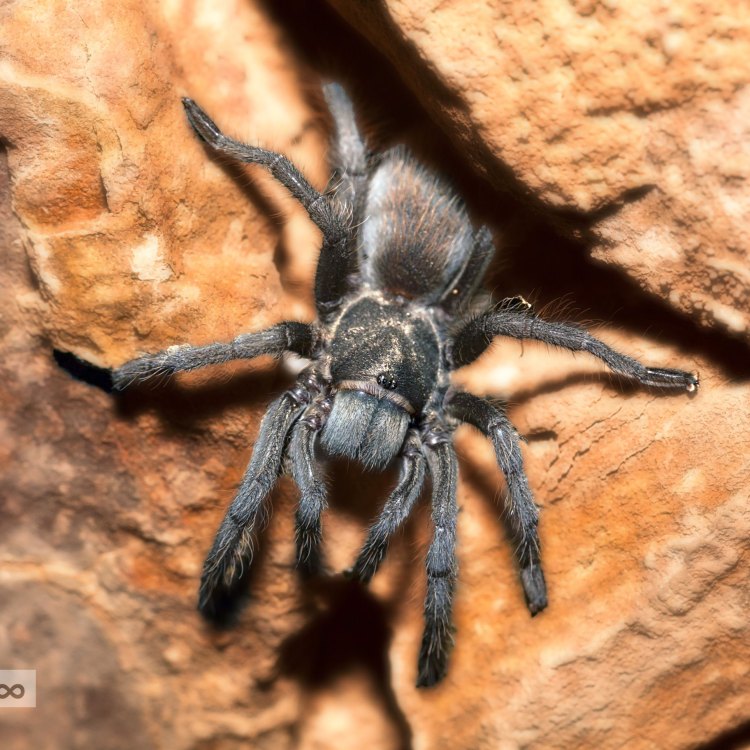
Arizona Blonde Tarantula
- Adult Size: 3-4 inches (7.6-10.2 cm)
- Average Lifespan: Up to 20 years
- Reproduction: Sexual
- Reproductive Behavior: Males embark on long journeys to find females; courtship involves drumming and vibration
- Sound or Call: None
- Migration Pattern: Non-migratory
- Social Groups: Solitary
- Behavior: Nocturnal and burrow-dwelling
- Threats: Habitat destruction and collection for pet trade
- Conservation Status: Not currently evaluated
- Impact on Ecosystem: Feeds on small insects and helps regulate their populations
- Human Use: Pet trade
- Distinctive Features: Light-colored hairs on the abdomen and legs
- Interesting Facts: 1. The Arizona Blonde Tarantula is one of the largest spiders in North America. 2. They are docile and are often kept as pets. 3. Their venom is relatively benign to humans.
- Predator: Various small mammals and birds
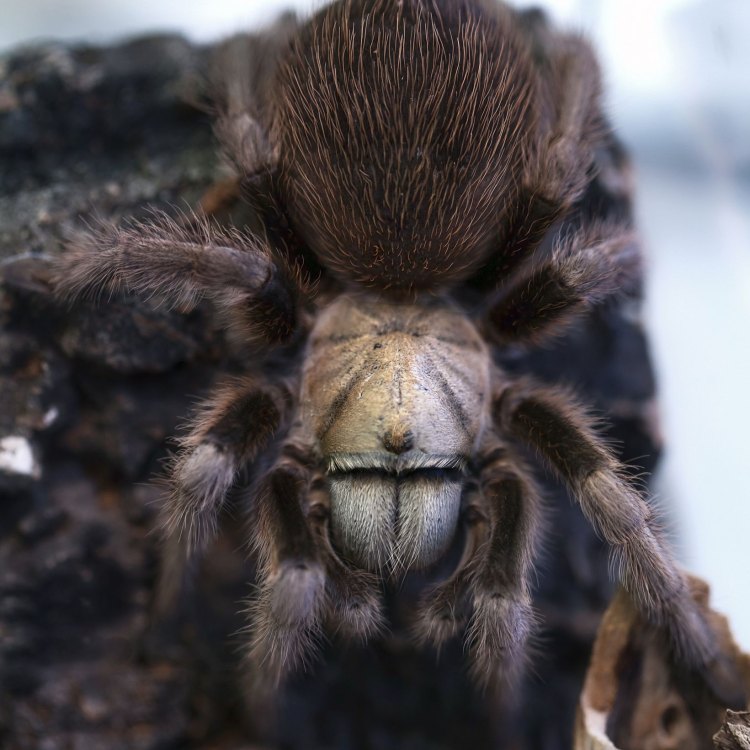
Aphonopelma chalcodes
The Fascinating World of the Arizona Blonde Tarantula
Many people may hear the word "tarantula" and immediately feel shivers running down their spine. This is not surprising, as these creatures have often been portrayed as terrifying and aggressive in movies and books. However, there is one species of tarantula that defies this stereotype - the Arizona Blonde Tarantula.With its distinctive light-colored hairs and docile nature, the Arizona Blonde Tarantula is a fascinating creature that deserves a closer look PeaceOfAnimals.Com. From its behavior to its impact on the ecosystem, there is much to discover about this unique species.
Size and Lifespan
The Arizona Blonde Tarantula is one of the largest spiders in North America, with an adult size of 3-4 inches. This may seem intimidating, but compared to its South American cousins, which can grow up to 11 inches, the Arizona Blonde is relatively small.Despite their large size, these tarantulas have a surprisingly long lifespan, with an average of up to 20 years. This makes them one of the longest-living tarantula species in the world. In captivity, they can live even longer, with some individuals reaching up to 30 years old.
Reproduction and Behavior
Like most spiders, the Arizona Blonde Tarantula reproduces sexually. During mating season, the males embark on long journeys to find females. This can be a dangerous journey for them, as they may encounter predators or rival males along the way Asp.Once a male has found a female, he will engage in a courtship ritual that involves drumming and vibration. This not only serves as a way for the male to communicate his intentions to the female, but it also helps to stimulate her and get her in the mood for mating.
After mating, the male's role is done, and he will often become a meal for the female. Female Arizona Blonde Tarantulas are known to be cannibalistic, and it is not unusual for them to consume their mates after breeding.
Solitary and Nocturnal
One of the unique behavioral traits of the Arizona Blonde Tarantula is that they are solitary creatures. They prefer to live alone, and each individual will have its own burrow. These burrows can be up to 3 feet deep and are lined with silk to provide protection and insulation.As their name suggests, these tarantulas are nocturnal, meaning they are most active during the night. During the day, they will retreat to their burrows or hide in crevices to avoid detection and potential predators.
Threats and Conservation Status
The biggest threats to the Arizona Blonde Tarantula are habitat destruction and collection for the pet trade. As human populations continue to expand, their natural habitats are being destroyed, leaving them with less space to live and breed.Unfortunately, these tarantulas are also highly sought after in the pet trade due to their docile nature and unique appearance. This has led to a decline in their wild populations, and they are now considered a species of least concern on the IUCN Red List.
In some states, it is illegal to own a tarantula as a pet, while in others, a permit is required. It is crucial for potential owners to research and understand the proper care and regulations before purchasing an Arizona Blonde Tarantula.
Impact on the Ecosystem
Contrary to popular belief, tarantulas play an essential role in maintaining the balance of the ecosystem. They feed on small insects and other invertebrates, such as crickets, grasshoppers, and beetles. This helps to regulate their populations, preventing them from becoming pests and causing damage to crops and gardens.Additionally, when these tarantulas dig burrows, they create small channels that allow air and water to penetrate the soil, helping to aerate and enrich it. They also provide a food source for larger predators, such as birds and mammals, further contributing to the overall balance of the ecosystem.
Human Use
As mentioned earlier, the Arizona Blonde Tarantula is sometimes kept as a pet. Given their docile nature, they can make excellent pets for those willing to invest in their care and maintenance. However, it is crucial to remember that they are wild animals and should be treated with respect and proper care.Their venom is relatively benign to humans, with mild irritation being the most common side effect. However, it is always best to avoid handling them and to seek medical attention if bitten.
Distinctive Features
One of the most striking features of the Arizona Blonde Tarantula is its light-colored hairs. These can range from light golden to a pale blonde, giving them their name. These hairs not only provide camouflage and help them blend into their environment but also serve as a defense mechanism. When threatened, these tarantulas can use their long, sharp hairs to irritate and distract predators.Another interesting feature is their ability to regenerate lost limbs. This means that if a tarantula loses a leg in a fight or while molting, it can grow it back, although it may not be as long or as sturdy as the original.
Interesting Facts
To conclude our journey into the fascinating world of the Arizona Blonde Tarantula, here are some interesting facts about this remarkable species:- These tarantulas are native to the desert regions of the southwestern United States and parts of Mexico, including Arizona, New Mexico, and Texas.
- They are also known as the Mexican Blonde Tarantula, referring to their range in Mexico.
- The Arizona Blonde Tarantula is not venomous to humans. Their venom is primarily used to incapacitate their prey.
- Despite their impressive size, these tarantulas are generally not aggressive and will only show aggression if threatened.
- They are skilled climbers and can scale vertical surfaces using their specially designed claws.
- Arizona Blonde Tarantulas can molt up to eight times in their lifetime.
- They are silent creatures and do not make any sounds or calls.
In conclusion, the Arizona Blonde Tarantula may not match the stereotype of a scary, aggressive spider, but it is undoubtedly a fascinating and unique creature. From their docile nature to their important role in the ecosystem, these tarantulas deserve our respect and protection. Let us continue to learn more about these amazing creatures and work towards preserving their natural habitats for future generations to enjoy.
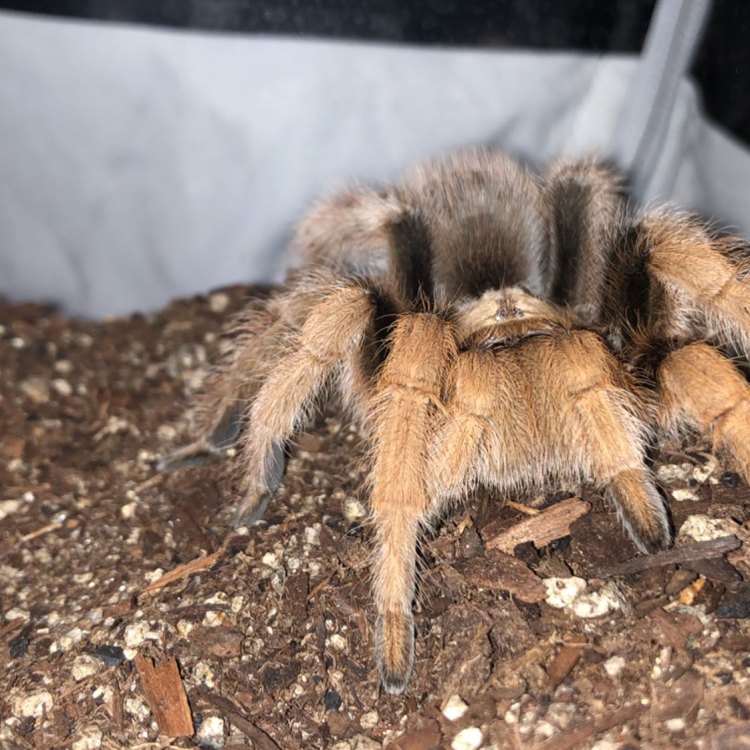
The Enigmatic Beauty of the Arizona Blonde Tarantula
Disclaimer: The content provided is for informational purposes only. We cannot guarantee the accuracy of the information on this page 100%. All information provided here may change without prior notice.







